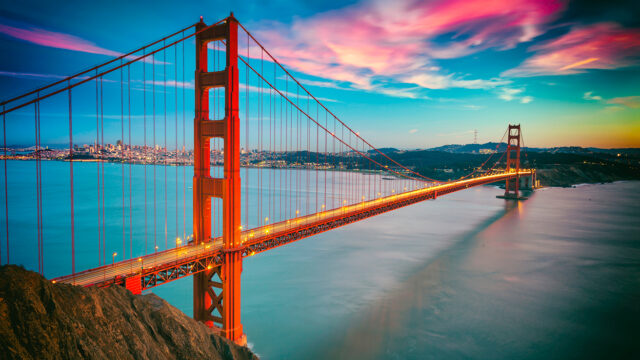
LOOK AHEAD TWENTY-FIVE YEARS, and the San Francisco you see today will look nothing like the city of the future.
There will be grand boulevards where transit vehicles, pedestrians, and bicyclists intermingle without the interference of the automobile. A new 49ers football stadium and modern neighborhood will have sprouted from the site of the old Hunter’s Point Naval Shipyard after decades of political hurdles and backroom manhandling to keep the fledgling football team from leaving town.
But stand-in Dolores Park in the heart of the city, or atop the Twin Peaks mountains nearby and you will see the most dramatic change of all – new and tall high-rises piercing the San Francisco fog. You will see skyscrapers taller than the Transamerica Pyramid, each with its unique shape and shimmer as rays of sunlight hit them.

The view from Treasure Island will be much the same. Tall, skinny towers will dot the landscape. The iconic Pyramid building will look like a drab, out-of-place concrete monstrosity situated next to the glassy modern structures to the south. The San Francisco we know now will become an unfamiliar sight in just a few decades.
WHAT WE ARE WITNESSING NOW is a massive boom in the construction of high-rise buildings in San Francisco’s South of Market neighborhood – a large swath of the city that is home to old industrial buildings and open lots. The area is ripe for development. It is centrally located within a five-minute walk of the Financial District, the ballpark for the San Francisco Giants, and the city’s spectacular waterfront.
Instead of building low-rise condos and townhouses on the many parcels of land up for development in SOMA (acronym for South of Market), developers and city planners are eager to capitalize on some of the spectacular views of the Bay and city that high-rise apartments and offices in the neighborhood can offer its inhabitants. And in a city where land is scarce and demand is high, there is no better way to appease both facets by building gigantic buildings that could end up becoming the tallest towers on the West coast.
SAN FRANCISCANS ARE GETTING A PREVIEW of what is to come already. At the east approach to the San Francisco-Oakland Bay Bridge, residents of One Rincon Hill who have pre-paid their way into the new 641-foot, the 62-story residential tower – the tallest of its kind on the west coast – will get to move in later this year as construction of the mammoth structure nears completion.
A second sister tower is slated to be constructed next to it. It will reach 495-feet and 45-stories when it is completed in 2009.
The project has received considerable attention since it first broke ground in 2005 most likely due to its prominent location atop the highest point in the SOMA neighborhood – Rincon Hill. It ascends up into the sky as the only high-rise tower currently in its vicinity.
Most residents who live nearby the project say that from afar, it looks out of place for an area that has rarely seen buildings top 10-stories. Detractors of the Rincon Hill project have called the building an eyesore, monolithic, and unfit for San Francisco’s skyline.
Jeffery Glover, a San Francisco resident who lives in the Castro District told the San Francisco Chronicle, “In San Francisco, it looks like we’re giving Oakland the finger.”
The developers call their project a bold move to attract wealthy residents into a unique high-rise condominium complex that intermixes urban living with sweeping vistas of the Bay waters in one of the world’s most scenic metropolises.
They want the project to become the newest San Francisco landmark building.
And for a mere $500,000, you too can move into one of the 376 condos in the tallest tower, each with its own spectacular view of the downtown skyline and San Francisco Bay off in the distance. The penthouse units located on the higher floors of the skinny bluish-white building are rumored to retail for a whopping $2 million.
THE VIEW FROM THE TOWERS GOING UP closer to the downtown core and Financial District of San Francisco is much the same of the One Rincon Hill project. At the corner of Mission and Fremont Streets, the Millennium Tower – an ambitious project to build a 645-feet, 60-story residential/ hotel skyscraper in Downtown San Francisco – is also becoming an attention-grabber. The building, near completion as of this writing, is a towering glassy blue structure that blends in very well in the sky, but stands out amongst the 1980s and 1990s-era drab concrete facade office towers in the neighborhood.
Like the One Rincon Hill developers, the Millennium Tower team is anticipating that the building will  become a landmark for the South of Market area. It will be the fourth-tallest building in the city when it opens sometime this year. The penthouse suites at the top levels of the building retails for $12 million each, making it the priciest residential tower in San Francisco.
become a landmark for the South of Market area. It will be the fourth-tallest building in the city when it opens sometime this year. The penthouse suites at the top levels of the building retails for $12 million each, making it the priciest residential tower in San Francisco.
And both projects are right now serving as a life-sized model of what is to come in the South of Market area, a part of town long ignored by tourists, rejuvenated by the dot-com boom and subsequent bust, and revitalized by young wealthy entrepreneurs looking for condominiums and lofts to call home
Now, it’s the site of an architectural renaissance of sorts – an ambitious project to bring a slice of New York City to the west coast.
Manhattan West, we’ll call it.
In Part Two of the CALIFORNIA BEAT’s special segment on the high-rising of San Francisco, we’ll explore the nexus of the grand plan to transform San Francisco into a mega-metropolis — the Transbay Center plan, which would usher in more than a dozen skyscrapers to a small segment of the downtown area. If built, the tallest tower would hold the distinction of being the highest building on the West Coast.









